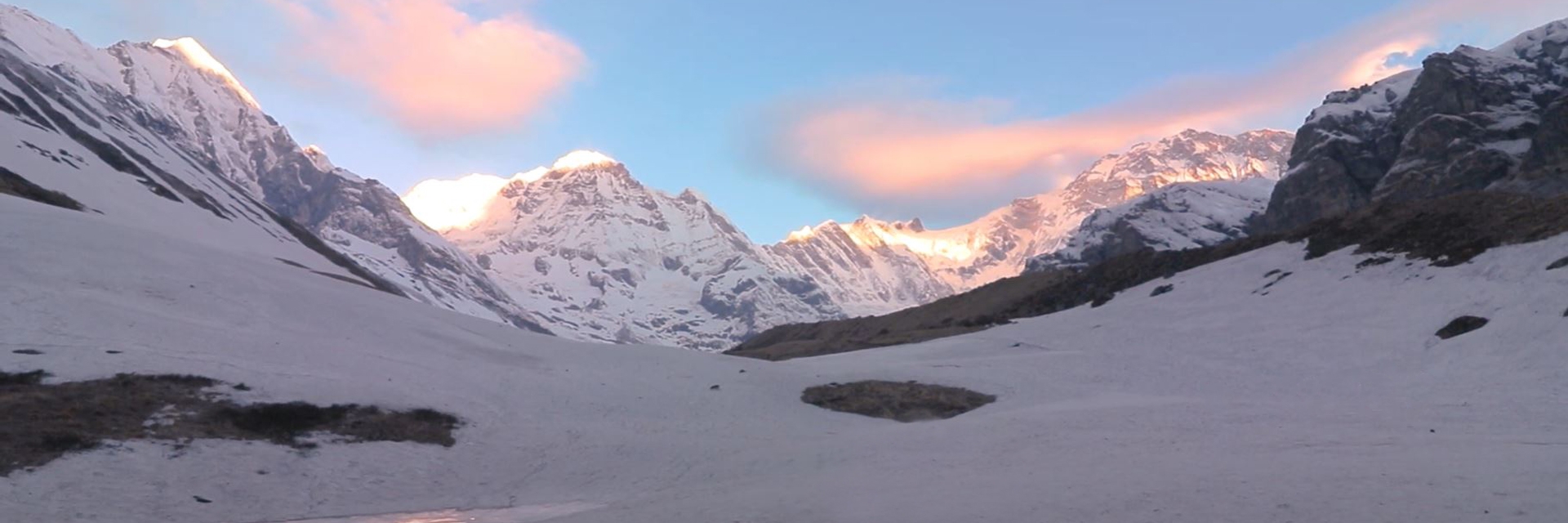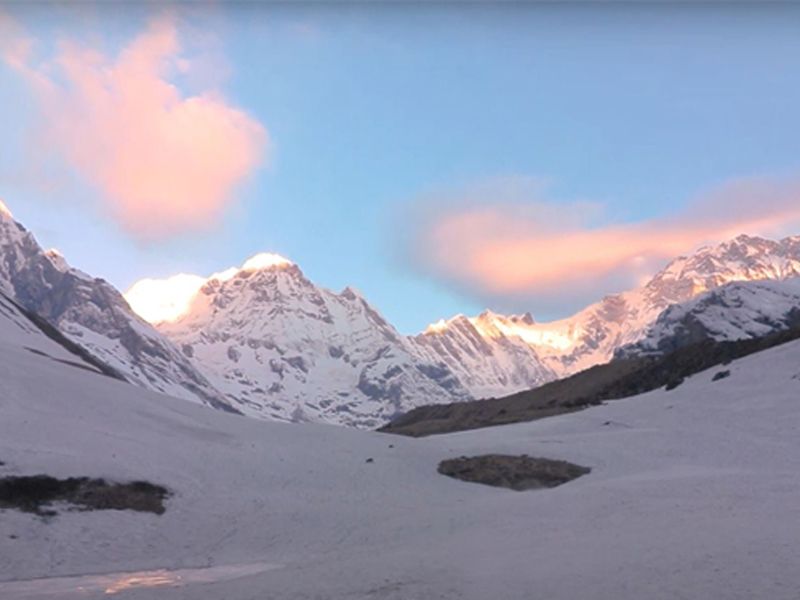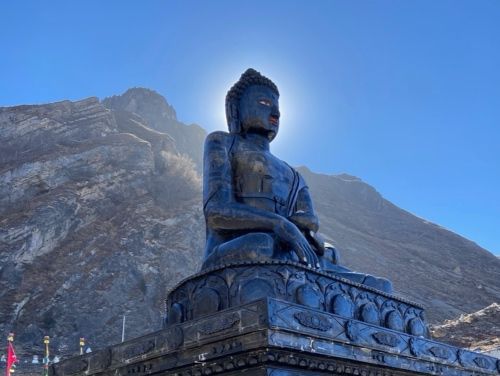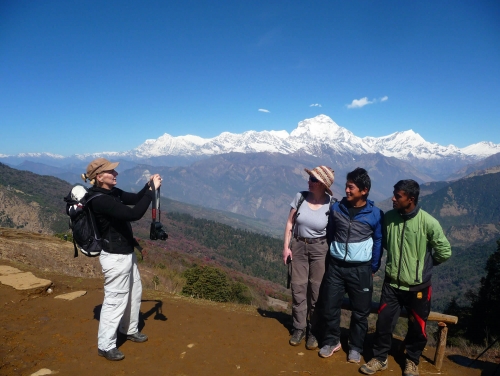Overview of Annapurna Base Camp Trek
People typically enjoy the Annapurna Base Camp Trek as one of Nepal's main Himalayan touring routes. Different scenery types appear on your journey during this trek, starting from forests and then ascending to alpine terrain.
The ABC trekking route leads from Nayapul as it journeys past the adorable settlements of Ghandruk and Chhomrong. As you travel through this trail you get to pass through rhododendron forests while crossing suspension bridges and will witness Mount Annapurna, Hiunchuli and Machapuchare.
The duration of Annapurna Base Camp Trek ranges from nine to twelve days, according to the chosen route and the speed of travel. This trek faces moderate difficulty levels which allow new hikers with good physical condition to participate.
You can get basic food combined with accommodation services at teahouse facilities located throughout the journey. Reaching Annapurna Base Camp Trek stands as the trekking's main highlight because it elevates to an altitude of 4,130 meters.
The path to Annapurna Base Camp is most suitable for visits during the autumn and spring seasons. The climatic conditions remain steady, with sunny, clear skies throughout the season.
The trail becomes extremely challenging because heavy snow covers it during the winter months. During monsoon season there are serious amounts of heavy rainfalls that result in dangerous slippery pathways.
To trek into the Annapurna Base Camp Trek, visitors must obtain permits, including the TIMS car and the ACAP permit. Cultural highlights accompany the visit to this site.
For your travel, you will encounter Gurung and Magar residents who are famous for their welcoming ways. After finishing the trekking route people can take advantage of the heated hot springs at Jhinu Danda for rest.
A trek to Annapurna Base Camp presents a fulfilling experience that awaits every participant. You can appreciate stunning mountain vistas alongside various trail types and immerse yourself in both the cultural heritage.
Significance of Annapurna Base Camp Trek
Breathtaking Mountain Views
Visitors to the Annapurna Base Camp Trek experience breathtaking outlooks of Mount Annapurna as well as its nearby peaks and mountains.
Trekkers have opportunities to observe Annapurna I, with its height of 8,091 meters as well as the peaks of Machhapuchhre and Hiunchuli and several others directly in front of them. The scenery undergoes persistent transformations because it displays both snowy mountain peaks and icy glaciers with steep valleys.
The beautiful hues of gold that sunset and sunrise bring to mountains result in breathtaking natural sights. Trekkers reach their peak in wonder when they enter Annapurna Base Camp because they stand inside a natural amphitheatre among enormous mountain peaks.
Travelers encounter stunning views at each point of this adventure, which results in a memorable trek. The route is widely recognized for its dramatic mountain vistas which bring international trekking enthusiasts to visit this route of Nepal.
Annapurna Base Camp
Visitors reach the climactic point of their journey when they arrive at Annapurna Base Camp, which stands proudly at 4,130 meters.
The base of Annapurna Base Camp spreads out among Annapurna I and Annapurna South and Hiunchuli and Machhapuchhre mountain ranges. Trekkers experience proud completion satisfaction upon arriving at the base camp.
The region contains a frozen sanctuary that displays breathtaking natural vistas. The whole panorama of mountains stretching before the view offers breathtaking sights.
A peaceful dawn lights up the mountain peaks as numerous trekkers start their days with this sight. The Annapurna Base Camp Trek presents trekkers with an exceptional opportunity to merge natural splendour with adventure thrill in an amazing single expedition.
Machhapuchhre Base Camp
Visitors can find Machhapuchhre Base Camp (MBC) positioned exactly at 3,700 meters between Annapurna Base Camp and its location.
From this location, visitors can see Machhapuchhre (Fishtail) peak, which stands sacred in Nepal. Visitors need two hours to walk from MBC to Annapurna Base Camp while travelling through alpine regions.
From its base, MBC provides visitors with an exceptional chance to unwind and admire awe-inspiring mountain views.
Machhapuchhre Base Camp resides in a serene area, attracting fewer visitors than Annapurna Base Camp. Trekkers usually choose to make MBC their base for resting before climbing up.
Machhapuchhre Base Camp functions as a critical stopping point in the trek because it offers summit views combined with mountain air freshness along with enticing exploration opportunities.
Diverse Landscape
The journey leading to Annapurna Base Camp presents trekkers with various geographic regions to walk through. A journey through these trails starts in forests that contain rhododendrons and bamboo plants along with their lush green landscape.
Going higher, you will pass through alpine meadows followed by rocky trails and glaciers. The trek gets more fascinating because it presents a combination of forested areas, river views, agricultural land and mountain heights. The mixture of different landscapes during the trek ensures both scenic beauty and demanding terrain.
Trekkers encounter complete environmental spectrum variations between tropical heat in low areas and freezing temperatures in elevated locations. Annapurna Base Camp Trek stands out as a rewarding trek because of its frequent changes in climate zones.
Meditative Trek Through Modi Khola River
The path of this trek moves beside the Modi Khola River which produces a calming atmosphere for reflection. The path of the trek sends sounds of flowing water throughout the entire journey.
The trek becomes more thrilling when trekkers cross bridges made from wooden structures and suspensions. A glacial stream named Modi Khola starts from the Annapurna Glacier before passing through forested areas and deep canyons.
The walking experience next to the river stream brings both relaxation and rejuvenation to most trekkers. The river environment allows an ecosystem that nurtures various types of plants and animals.
This trek provides an ideal break from urban daily life by creating experiences of adventure along with a state of spiritual tranquillity through its combination of natural sounds and pure mountain air in a peaceful setting.
Rich Cultural Experience
Annapurna Base Camp Trek provides its visitors with comprehensive cultural exposure. The Gurung and Magar peoples who live in this area maintain a well-known tradition of generous hosting.
Through traditional villages, including Ghandruk and Chhomrong trekkers can observe local customs and experience unique food as well as traditions. Some inhabitants of the area come from Gurkha soldier backgrounds, which enriches the cultural aspects of the region.
Along the paths, trekkers discover Buddhist prayer flags together with monasteries and chortens, which showcase the spiritual culture of the area. The local population can interact with travellers through both teahouses and homestay accommodations.
Tourists who visit Nepal experience an unforgettable trip through its cultural heritage while enjoying both its natural beauty and aboriginal traditions.
Natural Hot Springs at Jhinu Danda
Visitors from all over the world flock to the prominent Jhinu Danda spot on the Annapurna Base Camp Trek to enjoy its unknown hot springs gift of nature. Trekking for many days finally ends with a soothing and refreshing bath in the hot waters.
The natural hot springs in Jhinu Danda lie approximately 15 minutes walking distance from Modi Khola River in Jhinu village. Hot mineral waters at Jhinu Danda are thought to heal physical issues by soothing both joints and tired muscles.
The typical practice among trekkers includes soaking in the hot springs and then proceeding with their trek back. The hot spring location, surrounded by scenic mountains near the Modi Khola River, offers the perfect retreat before continuing the trek due to its warm waters and peaceful natural setting.
Annapurna Conservation Area
The Annapurna Base Camp Trek takes place completely within the extensive conservation realm of Annapurna Conservation Area, Nepal's largest protected division. The natural habitat supports a variety of wildlife types that include Himalayan tahrs together with langurs and numerous pheasant species.
Conservation programs in this region defend both endangered species as well as the distinctive biodiversity of the area. During the trek hikers enjoy walking beneath dominating forests consisting of rhododendrons along with bamboo and oak trees.
The natural environment benefits from sustainable tourism practices to preserve its state. Visitors must obtain permits to access the conservation zone because permitting fees support its preservation activities.
The protected zone functions to improve trekking by delivering an environment that combines natural splendour with ecological worth.
Sunrise and Sunset at ABC Trek
Along the Annapurna Base Camp Trek, the early morning and evening hours offer stunning vistas of mountain ranges. The Annapurna region's top sunrise viewing spots include Poon Hill, both Annapurna Base Camp and Machhapuchhre Base Camp.
Travellers create lasting impressions of seeing the first rays of the sun touch snowy mountain peaks during their journeys. The scene produces remarkable photographic moments through its golden colours.
The Annapurna Base Camp presents equally breathtaking views during sunset as its sky transitions through orange, pink, and purple hues. These brief connections with nature permit people to feel calm alongside a bond with the natural world.
The spectacular views emerge as the top draw of the trek since trekkers frequently dawn before sunrise or twilight to watch them.
Explore Typical Ghandruk Village
Ghandruk stands as one of many villages from the Gurung community which attracts trekking visitors along the Annapurna Base Camp trekking route. The place features stone-built houses and tight alleyways combined with vibrant native customs.
Visitors walking in the area will find the Gurung Museum, which teaches local cultural traditions. Travellers coming to this village can see the stunning views of Annapurna South and Machhapuchhre from their location.
The traditional Nepalese dining experience in community teahouses encourages visitors to enjoy typical regional meals at their locations throughout Nepalese towns. The villagers maintain such welcoming manners that visitors remember their time here.
Visitor accommodation in Ghandruk enables trekkers to discover rural Nepal while they admire remarkable mountain views. The cultural stop enhances the overall experience of mountain trekking.
How Hard is Annapurna Base Camp Trek?
The Annapurna Base Camp trek features moderate difficulty levels, which adjust depending on the trekker's physical fitness along with experience levels. Travelers experience altitude sickness at the highest elevation point of 4,130m.
The ABC Trek path features challenging slopes and extended stone steps, as well as unpredictable ground surfaces. Weather changes quickly, adding difficulty.
The trek's two toughest points exist at Ulleri's staircase of 3000 steps and the ascent from Chhomrong to Machhapuchhre Base Camp. Before the trek commences, all participants need to build their strength through cardio exercises and general training.
Each of these factors individually helps minimize the threats to safety during trekking activities. Climbing to Annapurna Base Camp demands trekking poles and suitable warm clothing because they ensure both safety and comfort.
Annapurna Base Camp for Beginners
New trekkers successfully finish their Annapurna Base Camp adventure when they prepare properly. Walking for 5 to 7 hours daily constitutes the biggest challenge during this trek, although the trek is not considered technical.
Climbing altitude proves to be the greatest obstacle while trekking through steep terrain that faces freezing temperatures. Before embarking on the trek participants need to engage in normal hiking practice while conducting leg exercises.
Carrying light loads along with using proper boots and staying hydrated throughout the trek will produce a successful outcome. Guides provide better assistance to their clients. A measured pace forms the fundamental strategy to prevent exhaustion during your hike.
Travellers reduce their risk of altitude sickness by using sufficient rest breaks combined with climbing more and more elevated heights. A 10-12-day travel period enables novice travellers to find better comfort during their journey.
Annapurna Base Camp for Regular Trekkers
Regular trekkers can do the Annapurna Base Camp Trek as the difficulty level is moderate and reasonable. Going on these trails demands both endurance to tackle the steep elevation and endure the lengthy descents.
Regular trekkers need 7–9 days to perform this trek successfully. Ulleri and Chhomrong feature the most challenging stone steps during the trek. The altitude does not vanish completely above the 3,500-meter elevation mark.
A person needs to prevent dehydration while performing the process at a consistent speed. To stay comfortable during the trek, a trekker needs to carry essential cold-weather equipment along with lightweight items.
The correct use of trekking poles during descent helps solve knee pain problems. Strategically planned vacation days alongside a schedule ensure both total comfort and contentment while trekking.
Annapurna Base Camp for Asian Trekkers
Trekking in the Annapurna Base Camp is simpler for Asian trekkers who originate from hilly areas. Individuals who live in lowlands face difficulties when trekking at high elevations and in frigid conditions.
The trekking experience becomes more difficult because participants need excellent leg strength to conquer the steep slopes. The main challenges during the Annapurna Base Camp tract include the effects of high-altitude sickness and temperature changes and adjusting to different foods.
It becomes difficult to trek during colder periods because of intense freezing temperatures. The trek requires trekkers to follow a progressive speed, proper hydration, and appropriate adaptation to altitude changes.
People from regions with humid climates should prepare for dry air conditions and cold winds during their trekking experience in Asia. The key to an easier trekking experience depends on having layered clothing and energy snacks along with appropriate trekking shoes.
Annapurna Base Camp Trek for Westerners
Western trekkers need to overcome the combination of altitude conditions including extreme temperature, and adjusted food requirements when they visit the Annapurna Base Camp Trek area.
People originating from plains require additional training before adapting to mountain elevations. Dry weather conditions and extremely cold temperatures make most of the trail difficult to traverse.
Some Westerners struggle with local food, so carrying familiar snacks helps. Hydration with moderate speed and alcohol prevention can lower the possibility of altitude sickness. Finally, appropriate winter equipment includes multiple clothing layers and sun protection.
Affecting both protection and route direction is the practice of hiring an area-native guide. The best time to trek through this location is during spring or autumn since conditions remain more favourable during these seasons.
How to prepare for ABC Trek Nepal?
Being properly prepared stands as the essential factor for undertaking the Annapurna Base Camp Trek. Trekkers need to develop their cardio abilities and work on both leg strength and endurance before their hike.
People planning outdoor activities should bring strong trekking boots and multilayered garments, sleeping bags, trekking poles and rain jackets. The prevention of altitude sickness requires acclimatization thus requiring people to keep their pace steady while staying hydrated.
It is advisable to obtain travel insurance, which provides coverage for high-altitude trekking. Guide-led treks provide protection and map-based direction as well as security during the trek.
The journey requires packing essential medicine and enough sunscreen together with small snacks. It is best to reserve teahouses during times of peak visitor activity. Rest days included in a well-arranged itinerary help to improve the overall trekking journey.
Trek Extension and Alternatives in Annapurna Base Camp trek
Various trekking extensions, together with alternative routes, exist for the Annapurna Base Camp Tre.k Tourists have the option to lengthen their visit or link different routes to the Annapurna Base Camp Trek. Popular extensions include:
Poon Hill Trek
The detour provides short but breathtaking views of sunrise across the Annapurna and Dhaulagiri Mountain ranges. Thrill-seekers who desire additional natural beauty should choose this option.
Mardi Himal Trek
This alternative route follows majestic ridge terrains and lets travellers get near Machhapuchhre (Fishtail Mountain).
Annapurna Circuit Trek
Taking a longer circular route around the Annapurna massif takes travellers through Thorong La Pass at 5,416 meters with endless culture and natural environments.
Khopra Danda Trek
This secluded path enables travellers to witness stunning mountain vistas and discover the secluded Khayer Lake destination.
How many days does it take for ABC Trek?
The duration of an Annapurna Base Camp Trek through different routes ranges from seven to twelve days. Depending on the selected trail along with the pace of the trek, the Annapurna Base Camp Tour spans between seven and twelve days.
Experienced hikers seeking a fast journey should consider the 7-day trek since it offers minimal rest. Breezing through an average 10 to 12-day trek provides sufficient time for acclimatization and better comfort throughout.
The 14-day ABC Trek itinerary features Poon Hill as one of its additional side trek destinations. The overall period of travel depends on personal fitness level, weather conditions and available scheduling flexibility.
The pace of a trek matters because it controls the development of altitude sickness while creating more enjoyable interactions with the Annapurna region's natural scenery and cultural attractions.
Altitude of Annapurna Base Camp
The Annapurna Base Camp Trek reaches a maximum altitude of 4,130m (13,549 ft). Key elevation points include Nayapul at 1,070m, Chhomrong at 2,170m, Machhapuchhre Base Camp at 3,700m, and Annapurna Base Camp at 4,130m.
Trekking above 3,500m increases the risk of altitude sickness, with symptoms such as headaches, dizziness, and nausea. Educated trekkers must ascend slowly in between stops while maintaining hydration and taking time to acclimatize properly.
A systematic climbing pattern has been implemented throughout the trek to enable bodies to adjust properly to decreasing oxygen levels, which results in better safety and comfort for trekkers.
Best Time for Annapurna Base Camp Trek
Spring during the period March to May, together with autumn, September to November, represent the best times to visit Annapurna Base Camp Trek. Springtime at Annapurna Base Camp brings forth the sight of blooming rhododendrons together with stable conditions and unobstructed mountain vistas.
During the autumn season, the trails remain dry and clean air prevails while visibility reaches its peak. During the cold winter months between December and February, the base camp trails are snowy and difficult to traverse. Heavy rainfall from June to August makes the trails both muddy and infested with leeches.
Travellers should plan their Annapurna Base Camp trek during the spring or autumn months since these are the optimal seasons for enjoyable temperatures combined with breathtaking views of the scenery.
Stretching within the right period of year provides increased security together with increased enjoyment for visitors to experience the superb mountain vistas of the Annapurna region at its peak beauty.
Annapurna Base Camp Trek Permits
Trekkers need two permits for Annapurna Base Camp Permits:
Annapurna Conservation Area Permit (ACAP) – NPR 3,000 (Foreigners), NPR 1,000 (SAARC)
These can be obtained in Kathmandu or Pokhara. Carrying permits is mandatory at checkpoints.




